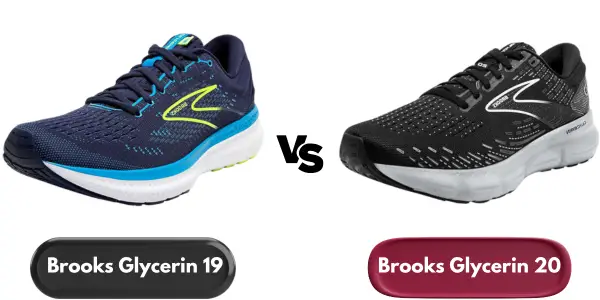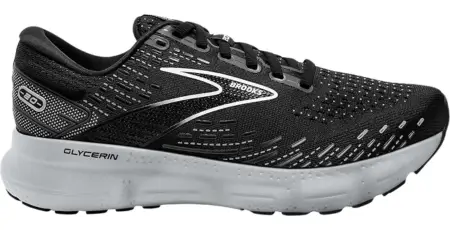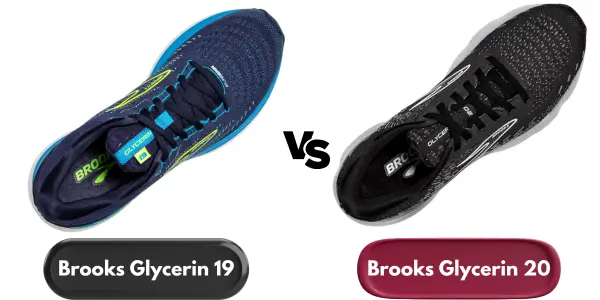Brooks Glycerin 19 vs 20 Running Shoes Comparison
Last Updated: January 01, 2025 | Author: Jake Thompson
As someone who doesn't shy away from the rigors of the road, I've found that the progression from the Brooks Glycerin 19 to the Glycerin 20 isn't just a step, but rather a stride into refined comfort and technology. This progression reflects Brooks Running's dedication to innovation, underscored by its strong market performance. Their commitment to advancing their product line is evident in the significant improvements from one model to the next.
In my professional experience, while the Glycerin 19 has served me well with its reliable cushioning, the anticipation surrounding the Glycerin 20's new features has piqued my interest. These enhancements, purported to offer a more luxurious underfoot experience and improved fit, could have significant implications for both casual joggers and marathon veterans alike.

I've taken it upon myself to lace up both pairs and put them through their paces. As we look into the subtle and not-so-subtle changes between these two models, I will unfold the layers of innovation that could influence your decision on which pair might be your next companion on the open road.
Table of Contents:
- Key Takeaways
- Table: Brooks Glycerin 19 vs 20
- Pros & Cons
- Performance Comparison
- Responsiveness
- Design
- Durability
- Support and Stability
- Comfort
- Breathability
- Cushioning
- Final Verdict
- Frequently Asked Questions
Key Takeaways
- - The Brooks Glycerin 20 offers a softer and more responsive cushioning compared to the Glycerin 19, thanks to the DNA Loft V3 technology.
- - The Glycerin 20 provides more support with its redesigned heel and tongue, making it a better option for runners who need stability.
- - The Glycerin 19 may not be suitable for summer runs as it tends to build up heat due to its thick padding, while the Glycerin 20 excels in breathability.
- - The Glycerin 20 feels more responsive and bouncy, making it a great choice for runners who prioritize quick and energetic strides.
Table: Brooks Glycerin 19 vs 20

|

|
|
|---|---|---|
| Features | Brooks Glycerin 19 | Brooks Glycerin 20 |
| Terrain | Road | Road |
| Pace | Daily running | Daily running |
| Toebox | Medium | Medium |
| Pronation | Underpronation | Neutral Pronation |
| Cushioning | Plush | Plush |
| All-day wear | ✓ | ✓ |
| For beginners | ✓ | ✓ |
| Jogging | ✓ | ✓ |
| Treadmill | ✓ | ✓ |
| Walking | ✓ | ✓ |
| Arch support | Neutral | Neutral |
| Heel-to-toe drop | 10mm | 10mm |
| Weight | 289g | 286g |
| Collection | Brooks Glycerin | Brooks Glycerin |
| Widths available | Normal, Wide, X-Wide | Normal, Wide |
| Orthotic friendly | ✓ | ✓ |
| Removable insole | ✓ | ✓ |
| Sustainable | - | ✓ |
| Distance | Long distance | Long distance |
| Breathable | ✓ | ✓ |
| Comfortable | ✓ | ✓ |
| Maximalist | ✓ | ✓ |
| Strike Pattern | Heel strike | Heel strike |
| Flexibility | Flexible | Moderate |
| Arch Type | High arch | High arch |
| Material | Mesh | Mesh |
| Forefoot height | 26mm | 24mm |
| Heel height | 36mm | 34mm |
| Price |
Pros & Cons
Brooks Glycerin 19
Pros- - Comfortable Cushioning with plush feel
- - Stable on various terrains
- - Durable construction for longevity
- - Breathable design for airflow
- - Not waterproof, unsuitable for wet conditions
- - Narrow fit may be tight for some
Brooks Glycerin 20
Pros- - Enhanced cushioning with a softer, more responsive midsole
- - Lightweight for easier running
- - Improved traction for better grip and stability
- - Adaptive fit accommodates more foot shapes
- - Better ventilation suitable for warmer weather
- - Not waterproof, limited use in rain
- - Slightly stiff, may require breaking in
Performance Comparison
When examining the responsiveness of both Glycerin models, it's crucial to consider the advancements in midsole technology.
The Glycerin 20's nitrogen-infused DNA Loft v3 not only enhances the shoe's responsiveness but also contributes to a lighter and bouncier feel.
In contrast, while the Glycerin 19 offers commendable performance, it doesn't match the refined responsiveness found in its successor.
Responsiveness
In comparing the responsiveness of Brooks Glycerin 19 vs 20, it's clear that the latter's nitrogen-infused DNA Loft v3 midsole delivers a more lively and energetic ride. When evaluating these running shoes, I'm particularly discerning about the performance aspects that affect my runs.
- 1. Midsole Technology: The DNA LOFT v3 technology in the Brooks Glycerin 20 offers a significant advancement in cushion and responsiveness compared to the older model.
- 2. Energy Return: The Glycerin 20 feels more responsive underfoot, providing that extra spring with each stride.
- 3. Comfort and Performance: Despite its plush comfort, the responsiveness doesn't compromise the smooth transition from heel to toe.
- 4. Efficiency: The updated design of the Glycerin 20 translates to a more efficient run, allowing me to maintain my pace with less effort.
| Feature | Glycerin 19 | Glycerin 20 |
|---|---|---|
| Cushioning | DNA LOFT | DNA LOFT v3 |
| Support | Neutral | Enhanced adaptive |
| Weight | Moderate | Lighter |
| Grip | Reliable traction | Improved traction |
| Breathability | Good | Enhanced |
| Durability | Durable | More resilient |
| Fit | Snug | Adaptive |
| Responsiveness | Standard | Higher (due to DNA Loft V3) |
Design
Delving into the design aspects of the Brooks Glycerin 20 vs 19, it's clear that both iterations showcase Brooks' commitment to combining aesthetics with functionality, yet they exhibit distinctive features that appeal to different runner preferences.
The Glycerin 19's upper construction prioritizes a plush interior, creating a snug and comfortable fit, while the 20 introduces a more streamlined, lightweight design that doesn't compromise comfort. Both models maintain an engineered mesh upper, but the Glycerin 20 refines this with a sleeker profile.
In terms of the heel, the Glycerin 19 offers a cozy, secure feeling, whereas the Glycerin 20 enhances the heel counter for better support without adding bulk. Each model balances the need for a comfortable ride with the structural integrity runners expect from a premium shoe.
The design evolution of the Glycerin series is a testament to Brooks' innovation. To get a broader perspective on how the Glycerin's design compares with other Brooks favorites, take a look at our comprehensive comparison of Brooks Ghost vs Glycerin.
Durability
Assessing the Brooks Glycerin models, it's evident that both models are engineered with materials and technologies designed to enhance their longevity and withstand the rigors of regular use. When I compare the two, here's what I find in terms of durability:
- 1. Outsole Robustness: Both shoes have high-abrasion rubber outsoles, yet the Brooks Glycerin 20 introduces subtle tweaks for improved wear resistance.
- 2. Midsole Durability: The recent DNA LOFT cushioning in the Glycerin 20 is designed to maintain responsiveness and comfort longer than the previous model.
- 3. Upper Wear: The engineered mesh in both running shoes is durable, but the Glycerin 20's upper might offer a slight difference in longevity due to updated materials.
- 4. Overall Longevity: Each Brooks Glycerin model is a testament to durability, with no significant compromise over countless miles.
For those curious about how other Brooks models fare in terms of durability, our Brooks Ghost 14 vs 15 comparison offers an in-depth look at the durability and resilience of these popular models.
Support and Stability
While evaluating the robustness and longevity, I've also scrutinized their performance in providing runners with the necessary support and stability. Both models offer commendable arch support, which is vital for a runner's foot health.
The foam technologies employed in these shoes, DNA LOFT for the 19 and the advanced nitrogen-infused version for the 20, contribute significantly to their stability. This is particularly important when considering the interaction between the runner's foot and the ground.
The Glycerin 20, with its updated foam, offers a more stable platform and improved energy return. Meanwhile, the collar design in both shoes ensures the foot is securely locked in place, reducing the likelihood of in-shoe slipping and enhancing overall stability.
Comfort
When comparing comfort, breathability and cushioning are pivotal points of focus.
I've found that while the Glycerin 19 offers a well-cushioned ride, the 20 introduces an advanced DNA LOFT v3 cushioning that provides a softer and more responsive feel.
Moreover, the Glycerin 20's engineered air mesh upper significantly enhances breathability, potentially offering a more comfortable experience in warmer conditions.
Breathability
Regarding breathability, the Brooks Glycerin 20 outshines its predecessor, offering a cooler and more ventilated running experience that doesn't compromise on comfort, even during the warmer months. Here's how:
- 1. Enhanced Upper Material: The Glycerin 20's engineered mesh is lighter and employs a more open weave pattern, allowing for greater airflow to keep feet cool.
- 2. Strategic Ventilation Zones: This running shoe features targeted ventilation areas that improve air circulation around high-sweat regions.
- 3. Moisture Management: The materials used in the Glycerin 20 are designed to wick away moisture more effectively, helping you stay dry and comfortably on the road.
- 4. Soft Interior Lining: Despite the focus on breathability, the shoe maintains a soft and plush interior, ensuring that comfort isn't sacrificed for the sake of staying cool.
Cushioning
The cushioning of Brooks Glycerin 20's nitrogen-infused DNA Loft v3 midsole offers a noticeably softer and more responsive ride compared to the traditional DNA Loft cushioning found in the Glycerin 19.

As a runner, I look for a shoe that can provide both comfort and performance, and the Glycerin 20 seems to hit the mark. The introduction of nitrogen has fine-tuned the softness without compromising on the bounce-back you'd expect from a high-caliber running shoe.
Moreover, the Glycerin 20 incorporates strategically placed flex grooves that work harmoniously with the updated midsole to enhance the overall feel underfoot. This results in a fluid transition from heel to toe, making my runs smoother and more enjoyable.
Final Verdict
Choosing between the Brooks Glycerin 19 and 20 depends on individual preferences. The Glycerin 19 offers reliable cushioning and a snug fit, ideal for those who appreciate consistency and a proven design. The Glycerin 20, with its advanced DNA Loft v3 technology, provides enhanced responsiveness, lighter weight, and better breathability, suitable for runners seeking innovation and comfort in warmer conditions. Both models have their unique strengths, making the decision a personal one based on specific running needs and priorities.
Choosing the right running shoe is about more than just comparing models. For a comprehensive guide, check out our articles on best shoes for walking on concrete.
Frequently Asked Questions
1. What are the major differences between the Brooks Glycerin 19 and Glycerin 20 running shoes?
The Glycerin 19 and 20 differ mainly in their weight and cushioning. The Glycerin 20 is lighter and offers an updated cushioning technology, making it ideal for runners seeking a more responsive feel. Additionally, the Glycerin 20 features an improved grip and traction, suitable for a variety of terrains.
2. Is the Brooks Glycerin 20 a suitable choice for long-distance training and recovery runs?
Yes, the Brooks Glycerin 20 is an excellent choice for long-distance training and recovery runs. Its light design and consistent cushioning provide comfort and support, making it ideal for runners who enjoy extended training sessions.
3. How does the Brooks Glycerin 20 perform in terms of speed and agility?
The Brooks Glycerin 20 is designed for speed and agility, with a lighter build and enhanced traction. It's ideal for runners who want to increase their pace without sacrificing comfort, making it a great choice for speed training sessions.
4. Which generation of Brooks Glycerin would you recommend for someone who prefers a heavier, more cushioned shoe?
For those who prefer a heavier and more cushioned running shoe, the Brooks Glycerin 19 would be a better suit. Its heavier build and plush cushioning accord with the needs of runners seeking ultimate comfort and support for their runs.
5. How does the latest Brooks Glycerin 20 compare to the Glycerin 19 in terms of midsole cushioning, upper construction, outsole grip, and traction?
The Brooks Glycerin 20 offers similar midsole cushioning to the Glycerin 19, with a plush and comfortable ride. The upper construction has been improved for a more secure fit. The outsole grip and traction remain excellent for running. Overall, the Glycerin 20 is a solid choice for runners, building upon the strengths of its predecessor.
Share this:







